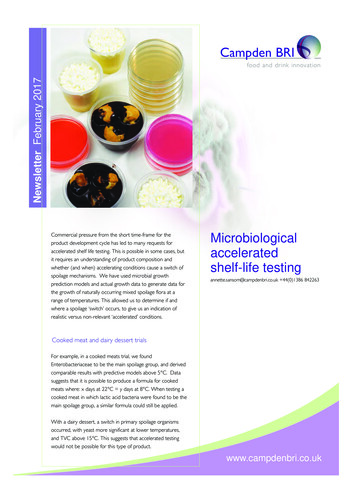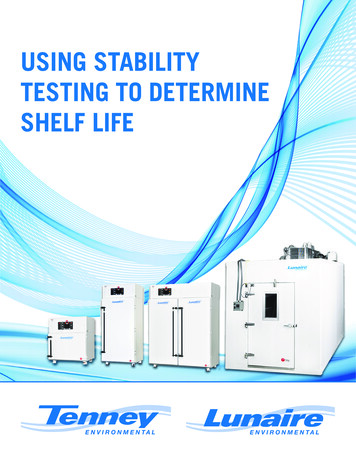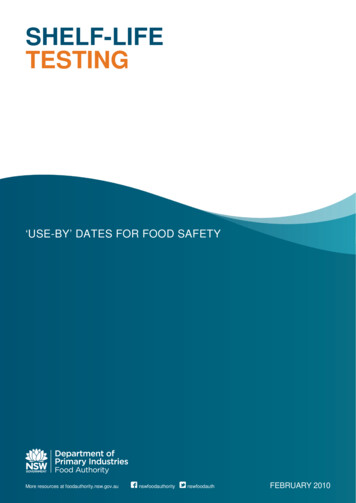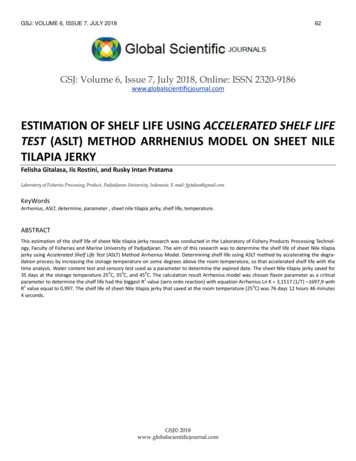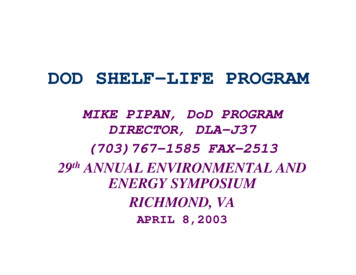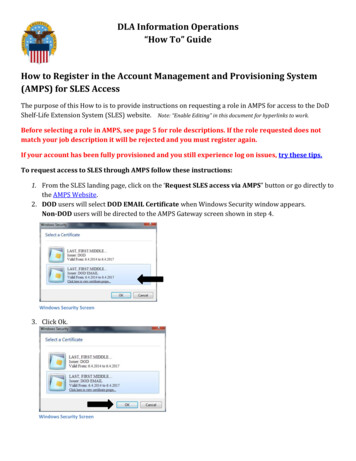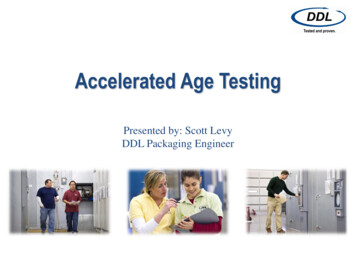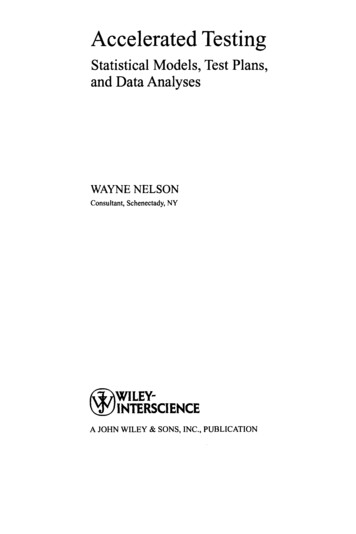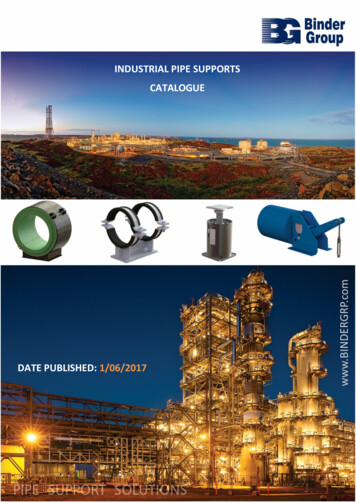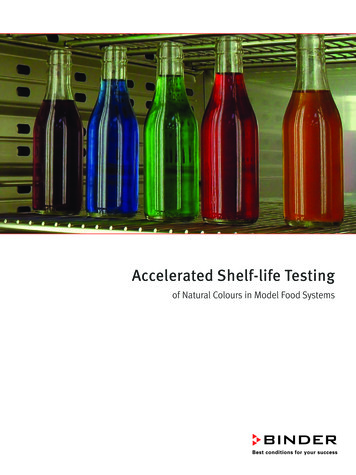
Transcription
Accelerated Shelf-life Testingof Natural Colours in Model Food Systems
Accelerated shelf-life testingContent3 Abstract4 Introduction5 Material and Methods6 Results8 Summary and Conclusions9 Imprint 2
Accelerated shelf-life testingAbstractA significant part of the UK food industry is moving from artificial colours towards naturalalternatives. However, natural colours are less stable and more expensive. The lack of stabilitycan be a problem when natural colours are added to food products with a long ambient shelflife.3 Normal shelf-life tests are time-consuming.2 To investigate and identify acceleratedtests for predicting the stability of natural colors (anthocyanin, lycopene, chlorophyll andCu-chlorophyllin) used singly as an ingredient in three different food matrices (high-boiledsweets, gelatine jellies, juice-based drinks).Samples were stored in a constant climate chamber at 20 C, 30 C and 40 C and exposed tohigh-intensity light at 4.000 Lux with UV at 1.4 W/m2 and in dark. Loss of color was monitoredin terms of change in Hue (ΔH) over time (7 months at 20 C and 8 weeks at 30 C and 40 C.1Results showed that the rate of acceleration of colour degradation was affected by the foodmatrix and the type of colour being used. In addition the results show that the use of elevatedtemperatures in combination with light allows samples to be screened for colour changeswithin shorter time scales.1 3
Accelerated shelf-life testingIntroductionThe shelf-life of a product is determined by storing the product under typical storage conditions thatthe product will experience, and measuring the changes occurring (chemical, microbiological andphysical) over a specified time interval until the product becomes unacceptable to consumers. Foodmanufacturers are under constant pressure to launch new products in shorter time scales and often donot have sufficient time for real time shelf-life testing. Accelerated shelf-life testing (ASLT) is an indirectmethod of measuring and estimating the stability of a product by storing the product under controlledconditions that increase the rate of degradation occurring in the product under normal storage conditions. In addition to the prediction of product stability including colour, ASLT are useful for a numberof other purposes, e.g. to determine product safety under abuse conditions, for troubleshooting in theinitial stages of product development and for assessing packaging performance of a product.3Figure 1: Constant climate chamber (Binder KBF 720) with door mounted lights used at Leatherhead FoodResearch for colour stability testing.3 4
Accelerated shelf-life testingMaterial and MethodsBinder KBF 720 with door-mounted lights2, Anthocyanin (E163), Chlorophyll (E140), Cu-Chlorophyllin(E141), Lycopene (E160d), High-boiled sweets1, Gelatine jellies1, Juice-based drinks1, HunterLab ColourQuest XE1Stability TestConditionsReal Time SorageAccelerated Storage ConditionsTemperature20 C30 C40 CTest with lightdaylight bulbsVIS 4.000 LuxUV 1,7 W/m2VIS 4.000 LuxTest without lightdarkdarkdarkTest periodup to 7 month8 weeks8 weeksIntervall of colormeasurementmonthlyweeklyweeklyTable 1: Stability test conditions maintained by a KBF 720.3 5
Accelerated shelf-life testingResultsIn this paper only the results of the anthocyanins colour stability tests for juice-based drinks arepresented. For further information please refer to the literature listed below.Figure 2:Appearance of juice-based drinks containinganthocyanin after storage.1Figure 2 shows the appearance of juice-based drinks after exposure at 30 C and 40 C. The fading ofthe redness from the anthocyanin was more obvious in the samples that were stored in the light compared to samples that were stored in the dark.1 The redness in samples stored at 40 C for five weeks,and in the light, faded quicker than samples that were stored at 30 C for 8 weeks and in the light. Thechange in Hue between samples stored at the elevated temperatures (30 C and 40 C) and betweenlight and dark storage is shown in Figure 3.1 6
Accelerated shelf-life testingResultsFigure 3: Effect of temperature and light on juicebased drinks containing anthocyanin.1Figure 3 also shows that the change in Hue (ΔH) increases with increase in storage temperature. TheΔH in the juicebased drinks was higher than that observed in the high-boiled sweets and gelatine jellies especially those that were exposed to light. As expected, samples stored in the dark had a lowervalue of ΔH compared to samples stored in the light at 30 C and 40 C except for samples at 20 Cwhich changed very little.1The relative rates of colour change for juice-based drinks containing anthocyanin are given in Table 2.Samples stored in the dark at 30 C and 40 C were 1 and 4 times faster compared to samples that werestored at 20 C and in the light. The rate of acceleration was much greater for samples that were storedin the light at 30 C and 40 C with rates of acceleration of 11 and 26 times faster, respectively. Thisindicates that light had a more detrimental effect for juice-based drinks containing anthocyanin thantemperature.1Rate of AccelerationJuice-based drinks withanthocyanin30 Cdark40 Cdark30 light40 Clight141126Tabele 2: Relative rates of colour change (juice-based drinks with anthocyanin) compared to 20 C in the light.1 7
Accelerated shelf-life testingSummary and ConclusionsFor juice-based beverage the systems with anthocyanins colour stability tests could be conducted attemperature of 30 C combined with light as colour change was 11 times faster than under real time20 C storage.1The change in colour (demonstrated as ΔH) showed that solid model systems (high-boiled sweetsand gelatine jellies tend to change more slowly than the liquid model system (juice-based drinks). Theanthocyanin molecules in the solid systems are thought to be bound more tightly than molecules ina liquid system and because of this the molecules are thought not to be able to move freely, resultingin a smaller change of colour.1Anthocyanin appeared to be most stable in the high-boiled sweets followed by gelatine jellies andjuice-based drinks as the values of ΔH were 10, 20 and 30 respectively after samples were exposedat 30 C and 40 C and high-intensity light.1Generally, a good correlation was found between actual and predicted results for high-boiled sweets,gelatine jellies and juice-based drinks containing anthocyanin and chlorophyll and a better correlationbetween actual and predictive results was seen for products stored in light compared to those storedin the dark.1The study showed that accelerated tests with a KBF 720 can be used to predict natural colour stability.2Please find detailed information on the KBF series at: www.binder-world.com. 8
Accelerated shelf-life testingImprint AutorIna Kanngiesser, BINDER GmbH, Im Mittleren Ösch 5, 78532 Tuttlingen, Germany References1.Teoh A., Subramaniam P.: “Forum Project Report No. 952, Stability of Natural Colours in Model FoodSystems”, October 2011, Leatherhead Food Research.2.http://www.binder-world.com.3.Teoh A.: “Predicting the stability of natural colours in food products, A review”, AgroFOOD Industry hitech, September/October 2010, Vol. 21 (5), 20-23. company profileAbout BINDER GmbH:BINDER is the world‘s largest specialist in simulation chambers for scientific and industrial laboratories. With its technical solutions, the company contributes significantly to improving the health andsafety of people. Our range of products is well-suited for routine applications, highly specialized workin research and development, production, and quality assurance. With approximately 400 employeesworldwide and an export rate of 80%, BINDER 2015 sales were more than 60 million euros. 9
Contact ContactBINDER GmbHIm Mittleren Ösch 578532 TuttlingenTel: 49(0)74 62-20 05-0info@binder-world.comwww.binder-word.com
Accelerated shelf-life testing (ASLT) is an indirect method of measuring and estimating the stability of a product by storing the product under controlled conditions that increase the rate of degradation occurring in the product under normal storage condi-
